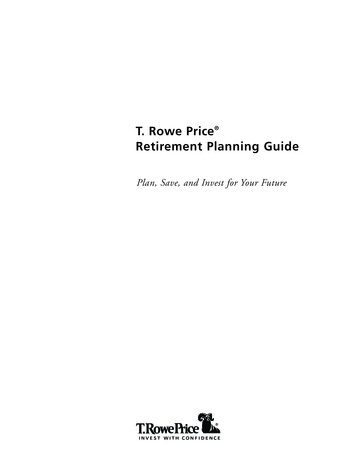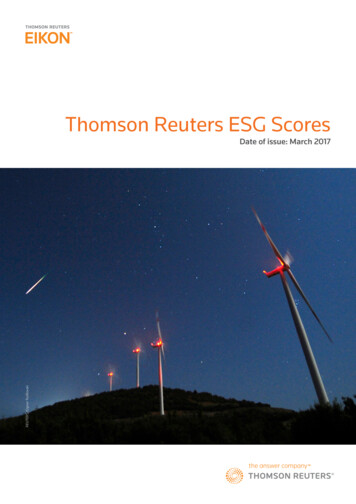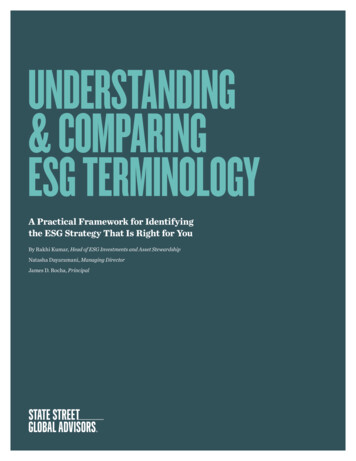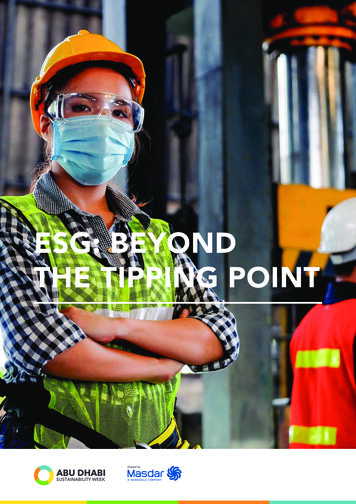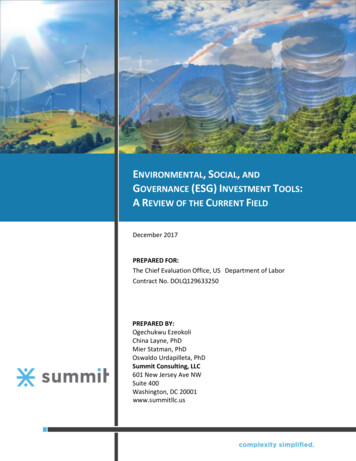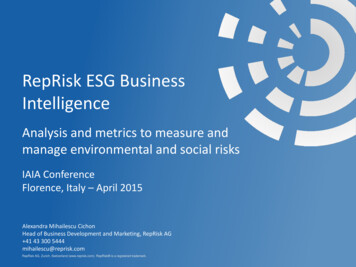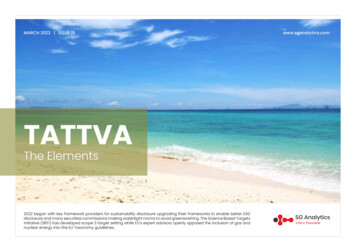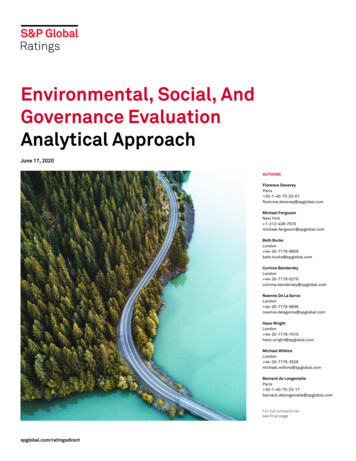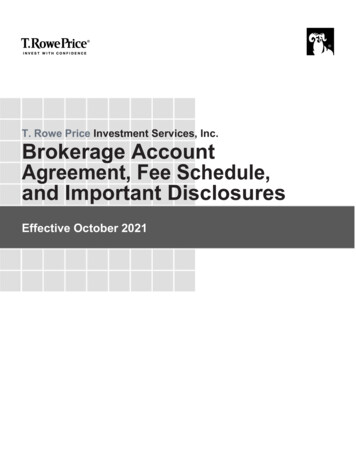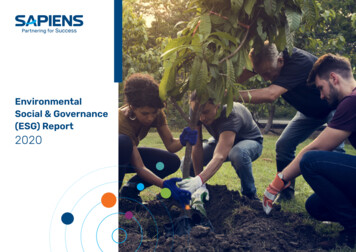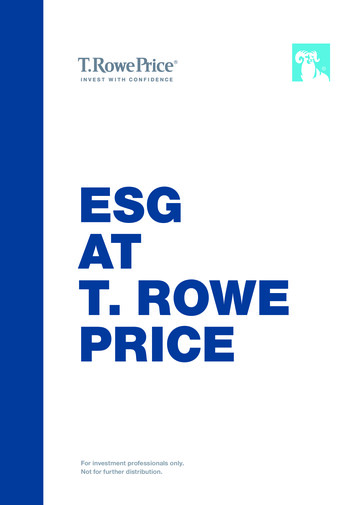
Transcription
ESGATT. ROWEPRICEFor investment professionals only.Not for further distribution.
ContentsIntroduction Defining ESG at T. Rowe PriceIntegrating ESG into our Investment ProcessResponsible InvestingResponsible Investing Indicator Model (RIIM)GovernanceCompany EngagementProxy VotingExclusion ListsESG OversightESG TrainingFrequently Asked QuestionsClimate Change357101213141617181922233
IntroductionAt T. Rowe Price, our central missionis to help our clients reach theirlong‑term financial goals. Consistentwith that objective, we have anobligation to understand the long‑termsustainability of the companiesin which we invest – which is whyenvironmental, social and governance(ESG) factors are a key considerationin our investment approach.5
Defining ESG atT. Rowe PriceResponsible investmentis an approachto investing thataims to incorporateenvironmental, socialand governance (ESG)factors into investmentdecisions, to bettermanage risk andgenerate sustainable,long-term returns.Principles for ResponsibleInvestmentIt is important to set out what we meanby ‘ESG’ and how we approach it, asthe umbrella term has given rise to amyriad of interpretations in the assetmanagement industry.As a signatory of the United Nationssupported Principles for ResponsibleInvestment (PRI)1 since 2010, wesubscribe to the association’s definitionof ESG integration and we considerenvironmental, social and governancefactors as components of the investmentprocess in order to enhance investmentperformance. We believe our investmentdecisions are better informed when weconsider these factors alongside moretraditional financial, industry‑related,macroeconomic and otherqualitative indicators.As ESG-integration is an enhancementto achieving a financial goal, we believe itcan be applied across a wide spectrum1of portfolios. As such, T. Rowe Price hasdeveloped in-house, proprietary ESGresearch tools and expertise that ourinvestors can leverage.In some cases, our clients have electedto place a values goal ahead of financialperformance. This type of portfolio isusually classified as a ‘socially responsibleinvestment’ and managed throughseparate accounts or funds with anexplicit approach.We believe that negative screening orexclusion based solely on ESG factorsneeds to be paired with a client’s valuerequirements. In other words, where adecision to exclude a security is madewithout consideration of other investmentfactors – such as financial fundamentalsand valuation – there is the potential for atrade-off of financial returns in exchangefor a value-driven objective.Launched in 2006, the Principles for Responsible Investment (PRI) are a set of voluntary bestpractice standards that asset owners and asset managers pledge to uphold in order to incorporateenvironmental, social, and governance (ESG) issues into their investment processes.7
Integrating ESGconsiderations into ourfundamental research hashelped the firm identifywell‑managed companiesthat are leaders intheir industries, moreforward‑thinking, better atanticipating and mitigatingrisk, and focused on thelong term.Bill StrombergPresident and CEO, T. Rowe PriceIntegrating ESGinto our investmentprocessOur investment approach is rootedin proprietary fundamental analysis,with ESG factors assessed alongsidefinancial, macro and other qualitativefactors. We believe ESG integrationis most effective when executed byexperienced investors who know thecompany or issuer well, which is why theresponsibility for integrating ESG intoinvestment decisions lies with our analystsand portfolio managers. Our researchanalysts incorporate ESG factors intocompany valuations and ratings, whileour portfolio managers balance the ESGfactor exposures at a portfolio level. Ourin-house ESG specialists support theinvestment team through all stages ofthe investment process: identification,analysis and integration.While ESG terminology tends to groupenvironmental, social and governancefactors into one bucket, we believethe ‘E’ and ‘S’ factors need to betreated differently to the ‘G’ factor.Corporate governance standardsare well established and generallyuniformly disclosed across the world,while disclosure of environmental andsocial factors is comparatively limited.Additionally, some factors we screen forin our ‘E’ and ‘S’ analysis fall outside thenormal scope of company disclosures,such as strained relations or incidentswith various stakeholder groups.As a result, our dedicated in-houseESG resource comprises two teams:Responsible Investing (‘RI’), which coversenvironmental and social factors, andGovernance. Together, these teams helpour investment teams identify, analyseand integrate the ESG factors most likelyto have a material impact on the long-termperformance of an investment.9
Governance:Responsible Investing:IDENTIFICATIONResearch tools assist in identifyingcompanies with ESG issues.Customised Proxy VotingGuidelinesResponsible Investing IndicatorModel (RIIM)Our in-house ESGspecialists have builttools to proactively andsystematically identifyESG risks embeddedin our investments.Investors across allasset classes benefitfrom these insights.”ANALYSISESG specialists apply furtheranalysis to companies flaggedby our ESG research tools.Companies flagging as divergentfrom T. Rowe Price’s guidelinesundergo further analysis by theGovernance team, which oftenincludes engagement and proxyvoting recommendationsCompanies flagging red, orange,or that are not covered by themodel undergo further analysisby the RI team, which can includeengagement initiatives and proxyvoting recommendationsINTEGRATIONESG specialists escalaterelevant issues to analystsand portfolio managers.Analysts and portfolio managersuse governance analysis toincorporate relevant factors in: Investment thesis Company ratings/price targets Identifying/conductingengagements Position sizing Proxy voting decisions10Analysts and portfolio managersuse responsible investinganalysis to incorporate relevantfactors in: Investment thesis Company ratings/price targets Identifying/conductingengagements Position sizing Proxy voting decisionsRob SharpsHead of Investments, T. Rowe PriceESG specialists escalate relevant issuesto analysts and portfolio managers.
ResponsibleInvestingTo help our analysts and portfoliomanagers consider the impact ofenvironmental and social factors, the RIteam conducts analysis on individualsecurities as well as the wider portfolio. Italso assists with company engagement.Since ‘E’ and ‘S’ data points are notalways readily disclosed by companiesand other issuers, we have built aproprietary model that systematicallyand proactively screens the RI profileof an investment. This model is calledthe Responsible Investing IndicatorModel (RIIM).RIIM uses ESG data from third-partyvendors, T. Rowe Price databases andcompany reports to cover a universeof 13000 corporate entities. Forinvestments not covered by RIIM, ourRI team screens for environmental,social and ethical controversies using athird-party provider and – where enoughinformation is available – conducts afundamental evaluation of the company’sRI profile.What does RI analysis reflect?Environmental management of thecompany’s own operations are relatively good(although emissions disclosure is limited),but there is no evidence of the same levelof environmental management as it relatesto raw materials procurement and endproduct sustainability.Investment take-away: This companycould be vulnerable to changing consumerpreferences. We would see this as along‑dated risk to the business model, ifthe company didn’t adapt over time.Flags on employee treatment are relatedto the flags on business ethics, lobbying &public policy and accounting & taxation. Thiscompany has a disruptive business modelthat has not been subject to all of the sameregulations of many of its competitors, withtraditional business models.Investment take-away: The evolvingregulatory environment around disruptivebusinesses will likely impact this company.Our investors actively consider this issue intheir analysis of the company.The most basic utility of RIIM is thatit flags any elevated RI risks with aninvestment. But RIIM can also serveto identify investments with positive RIcharacteristics and manage RI factorexposures at the portfolio level.1213
ResponsibleInvesting IndicatorModel (RIIM)There are four main reasons why we think RIIM is an improvement on third-partyvendor analysis:1IMPROVED MATERIALITY§§ RIIM aligns ‘E’ and ‘S’ factor materiality with investment materiality.§§ RIIM helps to screen out ‘green-washing’ efforts.§§ Factor materiality is more accurate as it is assessed at the sub-industry level.2Governancepredominantly comprised of investmentprofessionals. In addition to informingour proxy voting process, the guidelinesreflect T. Rowe Price’s perspective onthe appropriate governance standards ineach region.Monitoring the management,performance, strategy and governanceof the companies in which we investis a natural extension of our long-term,fundamental investment process.Our in-house governance team worksdirectly with analysts and portfoliomanagers to assess governance issuesamong existing and potential investments.They also help engage with companiesand facilitate proxy voting.If a company is flagged as divergent,it will be subject to further analysisby our governance team. This stageoften includes engagement and proxyvoting recommendations.Governance analysis starts with our proxyvoting guidelines, which are set annuallyby our proxy voting committee that isIMPROVED COVERAGE§§ RIIM provides systematic and proactive analysis beyond that of third-party vendors.Our approach to governance analysis is differentiated because it is:3FEWER ‘FALSE ALARMS’§§Investment-driven: Portfoliomanagers and analysts often raiseand identify areas of concern.§§Conducted in-house: Votingand engagement decisions arenot outsourced.§§Flexible: Governancestandards are evaluated inlight of regional, industry andcompany circumstances.Our RIIM analysis improves on that of third-party vendors in that:§§ RIIM information is more up-to-date.§§ Third-party vendors may rate companies poorly for lack of disclosure even when there isno record of negative incidents.§§ Companies may rank as ‘underperformer’ or ‘laggard’ because a third-party vendor hasforce-ranked the industry, when in reality RI practices are not that differentiated betweenhigh and low scoring companies in the industry.4COMPATIBILITY WITH T. ROWE PRICE’S INVESTMENT STYLE§§Compatible with our investmentstyle: Because governance isembedded into our investmentprocess – and portfolio managersare involved – we ensure ourgovernance and investmentpriorities are aligned and there isa coherent external message.§§ Our proprietary model is designed for practical application by our analysts andportfolio managers.15
CompanyEngagementOur engagement program is a naturalextension of our investment process.When we identify a practice or decisionwe believe will have negative long-termfinancial repercussions for our clients,we will engage with the company. In ourexperience, engagement is most effectivewhen it is directly led by our portfoliomanagers in the form of formal writtencommunication, meetings and calls withmanagement or the company’s board.companies. This affords us, in mostcases, access to company managementteams and board members.We believe our responsibilities as diligentinvestors do not cease with the decisionto purchase a security. We maintainregular dialogue with the managements ofissuers represented across our portfolios– and where we find areas of concern, wemake those concerns known.Engagement, proxy voting activities,and assessment of a broad range ofinvestment considerations—including ESGissues—are integrated into T. Rowe Price’sinvestment processes. Based on our viewthat these issues are important investmentconsiderations, our engagement programis driven by our investment professionalsand usually focused on a matter materialto the investment case. It is conducted by§§Who represents shareholders on acompany’s board? Is the board astrategic asset for the company?§§Which factors drive the executivecompensation program and,therefore, the incentives ofmanagement?§§Thanks to the trust our investment clientshave placed in us, T. Rowe Price isinvested in many of the world’s largestGenerally, we have three possible objectives when initiating engagement:1Obtain informationfrom an issuer toassist us in makinginvestment orvoting decisions.162Share our perspectivewith an issuer ona matter relating tocorporate governanceor sustainability.3How robust are shareholders’ rightsat the company?our portfolio managers with the supportof our industry-focused analysts andour in-house specialists in corporategovernance and sustainability to leveragetheir expertise on specific companies,industries, or issues of an environmental,social, or governance nature. Ourengagement approach is driven byinvestment issues such as:§§How well is the company managingits environmental risks, humancapital, facilities, stakeholderrelations, and long-term access tocritical resources?§§Are there ESG risks that couldnegatively affect the interests ofbondholders during the periodbefore the instrument matures?Occasionally we participate with other investors in industry-level initiatives aimed atimproving disclosure or business practices on a market-wide level. However, the centralfocus of our engagement program is at the company level. We believe this has the highestimpact because it is aligned with our core investment approach: active management rootedin fundamental investment analysis.Accommodate anissuer’s request toshare information orperspective with us.17
Proxy VotingProxy voting is a critical component ofour corporate governance approach,and we offer our clients a high degreeof visibility over the votes we cast ontheir behalf. Disclosure of our votingguidelines and record can be found onour corporate website.Shareholder proposals relating toenvironmental or social concerns havebecome more frequent in recent years.18We take a case-by-case approach toanalysing these proposals, leveragingresearch reports from our external proxyadvisor, company filings and sustainabilityreports, public research from otherinvestors and non-governmentalorganisations, our internal industryresearch analysts, and our in-housesustainability experts. Generally, wesupport proposals that stand to improve acompany’s business model.Exclusion ListsAll portfolios are subject to sanctionrelated exclusions. At any point in time,a portfolio may be prohibited frominvesting in certain sovereign or corporateinstruments associated with targeted USor international sanctions.In addition, we have a limited set ofexclusions across our investmentportfolios. For example, we have a globalexclusion list of issuers with significantbusiness ties to the governmentof the Republic of Sudan and itsconnection to human rights abuse. Inour European and Canadian portfolios,we maintain an exclusion policy oncertain issuers with direct exposure tothe ongoing manufacture, production,or assembly of anti-personnel landmines, cluster-munitions systems andincendiary weapons.In our Australian portfolios, we maintainan exclusion policy on companies withdirect exposure to tobacco production.
ESG OversightOverall oversight for ESG integration isheld at the senior management level –specifically, Head of Investments andGroup Chief Investment Officer RobSharps, and co-head of Global EquityEric Veiel. Our dedicated, in-house ESGresources report directly to the seniormanagement level, with the Director ofResearch, Responsible Investing, MariaElena Drew, reporting to Mr. Sharps,and the Head of Governance, DonnaAnderson, reporting to Mr. Veiel.The Directors of Research for equity andfixed income have oversight of investmentanalysts and how they implement ESGfactors in their investment process,which is a component of each analyst’sannual performance review. In assessingan analyst’s implementation of ESGfactors, the Directors of Research willreceive input from Director of Research,Responsible Investing and Head ofGovernance.Our analysts and portfolio managers areresponsible for implementation. It is theanalyst’s responsibility to incorporate20ESG risk analysis into the investmentdecision; he or she will consider the fullspectrum of relevant risks in makingan ultimate recommendation about asecurity. Depending on the strategy,portfolio managers may apply extralayers of implementation by screeningtheir portfolios for ESG issues on aperiodic basis. For their part, our RIand Governance subject-matter expertsprovide research, tools and support to ourglobal team of investment analysts andportfolio managers.These specialists have accountabilityfor implementing ESG factors into theinvestment process via our regularperformance-review process.Additionally, the Board of Directors ofT. Rowe Price has oversight on ESG.The Board will receive an update onESG activities at T. Rowe Price on anannual basis.ESG TrainingEvery new analyst who joins T. RowePrice is trained in responsible investingand corporate governance as partof an in-depth, multi-day departmentorientation. In addition to this formaltraining, discussions about ESG factorsare a routine part of the dialogue betweenour analysts and portfolio managers,particularly when a new investment isunder consideration.On top of our new analyst training, wehold forums with investment professionalsacross the firm to explore the integrationof environmental, social and governancefactors in the investment process.21
23
Frequently AskedQuestionsHow do you factor for longer-term ESG themessuch as climate change?The implications of climate change arecatalysing the rapid evolution of regulationand consumer demand around the world.Our investment professionals capture theimpact of climate change as part of theirESG analysis, which is embedded in ourinvestment process.also helping to reinforce the notionthat climate-related risk assessment isa priority. We believe companies thatengage in long-term strategic planning,including in-depth analysis of ESGfactors such as climate change, benefitfrom that experience. Looking inward toassess their own mission and purpose– to think about how the competitivelandscape is evolving over long periodsof time and consider how changes inthe broader community might affectthe company – are processes that helpalign the company’s direction with theinterests of its shareholders. Furthermore,when a company’s radar is tuned intolong-term climate and societal shifts,it may be better positioned to createnew opportunities.We believe speaking with companymanagement and other stakeholdersabout climate change is an effectiveway to gather valuable investmentinsights about management’s processfor assessing long-term risks, whileEngagement with managementteams or board members on climatechange is usually conducted as partof a multifaceted discussion on manyinvestment considerations for thatparticular company but occasionallyWe believe long-term ESG issues,including climate change, can influenceinvestment risk and return and thereforeincorporate them into our fundamentalinvestment analysis. We executescenario analysis, which includes factorsrepresenting the investment impacts offuture environmental and social trends.The type of factors analysed in ourscenario analysis will vary by industryand region.24Climate ChangeWe believe climate change is one long-term ESG issue that caninfluence investment risk and return. The implications of climatechange are changing regulations and consumer demands aroundthe world. Our investment professionals capture the impact ofclimate change through many lenses as part of the investmentprocess. For example, climate change factors are capturedin RIIM (our proprietary RI analysis) in several categories:supply chain, operations, end-product and ethics. Additionally,climate change factors are frequently incorporated in ouranalysts’ financial forecasts. We believe speaking with companymanagement and other stakeholders about sustainability topicsis an effective way to gather valuable investment insights aboutthe management team’s process for assessing long-term risks,as well as helping to reinforce the notion that ESG-related riskassessment is a priority.could focus only on climate changeimplications. Given that T. Rowe Pricehas predominantly actively managedportfolios, we have the option not toinvest in a company with onerous climatechange risk.As a result, our engagements on specificESG issues like climate change tend totake the form of in-depth discussions,where we believe our engagement canbe effective.25
Do you incorporate the UN Global Compact Principlesand/or UN Sustainable Development Goals (SDGs) inyour investment process?External sources, such as the UN GlobalCompact Principles and UN SustainableDevelopment Goals (SDGs), help usunderstand environmental and societalpressure points. We believe these arerelevant to the investment processas companies contributing to thesepressures are likely to face greater socialscrutiny over time. This could come in theform of more regulatory burdens, taxation,litigation and/or consumer dissatisfaction.Conversely, companies that act as‘solutions providers’ are likely to havemuch more sustainable business models.The UN Global Compact Principlesoverlap with many input factors thatdrive our proprietary RIIM. For example,in our model, the management ofhuman capital is assessed in manyways, including supply chain analysis forhuman rights violations, labour-related26incidents, and metrics such diversity.From an environmental perspective, weassess the environmental performanceof the company on many metrics,including its energy and emissions, water,waste, outputs and targets, sustainablesourcing of raw materials, and endproduct sustainability and impact onthe environment. Finally, anti-corruptionis factored into the ethics portion of ourmodel, allowing us to not only assessthe programs in place but also highlightthe track record of the company. Webelieve taking these RI input factorsinto consideration alongside companyfundamentals allows us to make a fullyinformed investment decision.The UN Sustainable Development Goals also overlap with many input factors:27
Are you involved in collaborativeengagement activities?We selectively take part in collaborativeinitiatives. We are generally affordeddirect access to the management ofcompanies in our clients’ portfolios,but we consider collaboration with other28investors on engagement initiatives ona case‑by‑case basis. T. Rowe Price hasjoined or led the following initiatives tobring investors together for purposes ofadvocacy or engagement.OrganisationDescriptionStatusAsia Corporate GovernanceAssociation (ACGA)Pan-Asian association for institutionalinvestorsMemberAssociação de Investidoresno Mercado de Capitais(AMEC)Association of minority investors in Brazil MemberCouncil of InstitutionalInvestors (CII)U.S. association of institutional investors,corporate issuers, and asset managersAssociate MemberInvestor CDPAdvocacy group for better disclosure ofcarbon emissionsSignatoryInvestor StewardshipGroup (ISG)Investors advocating for coregovernance principles for U.S. marketparticipantsFoundingMemberJapan Stewardship CodePublic commitment to upholdstewardship principlesSignatoryPrinciples for ResponsibleInvestmentGlobal initiative for responsibleinvestmentSignatoryUK Investor ForumCollaborative engagement associationfor investors in UK companiesFoundingMemberUK Stewardship CodePublic commitment to upholdstewardship principlesSignatory29
Important InformationThe specific securities described above donot necessarily represent securities that werepurchased, sold or recommended and noassumptions should be made that the securitiesdiscussed were or will be profitable. All analysisexamples are shown for illustrative purposes only.DIFC – Issued in the Dubai International FinancialCentre by T. Rowe Price International Ltd. Thismaterial is communicated on behalf of T. RowePrice International Ltd. by its representative officewhich is regulated by the Dubai Financial ServicesAuthority. For Professional Clients only.This material is being furnished for generalinformational purposes only. The material doesnot constitute or undertake to give advice of anynature, including fiduciary investment advice,and prospective investors are recommended toseek independent legal, financial and tax advicebefore making any investment decision. T. RowePrice group of companies including T. RowePrice Associates, Inc. and/or its affiliates receiverevenue from T. Rowe Price investment productsand services. Past performance is not a reliableindicator of future performance. The value of aninvestment and any income from it can go downas well as up. Investors may get back less than theamount invested.EEA ex-UK – Unless indicated otherwise thismaterial is issued and approved by T. Rowe Price(Luxembourg) Management S.à r.l. 35 Boulevarddu Prince Henri L-1724 Luxembourg which isauthorised and regulated by the LuxembourgCommission de Surveillance du Secteur Financier.For Professional Clients only.The material does not constitute a distribution,an offer, an invitation, a personal or generalrecommendation or solicitation to sell or buy anysecurities in any jurisdiction or to conduct anyparticular investment activity. The material hasnot been reviewed by any regulatory authority inany jurisdiction.Information and opinions presented have beenobtained or derived from sources believed tobe reliable and current; however, we cannotguarantee the sources’ accuracy or completeness.There is no guarantee that any forecasts madewill come to pass. The views contained herein areas of the date written and are subject to changewithout notice; these views may differ from thoseof other T. Rowe Price group companies and/or associates. Under no circumstances shouldthe material, in whole or in part, be copied orredistributed without consent from T. Rowe Price.The material is not intended for use by personsin jurisdictions which prohibit or restrict thedistribution of the material and in certain countriesthe material is provided upon specific request.It is not intended for distribution to retail investorsin any jurisdiction.30South Africa – T. Rowe Price International Ltd(“TRPIL”) is an authorised financial servicesprovider under the Financial Advisory andIntermediary Services Act, 2002 (FSP LicenceNumber 31935), authorised to provide“intermediary services” to South African investors.Switzerland – Issued in Switzerland by T. RowePrice (Switzerland) GmbH, Talstrasse 65, 6thFloor, 8001 Zurich, Switzerland. For QualifiedInvestors only.UK – This material is issued and approved byT. Rowe Price International Ltd, 60 Queen VictoriaStreet, London, EC4N 4TZ which is authorisedand regulated by the UK Financial ConductAuthority. For Professional Clients only.Australia – Issued by T. Rowe Price AustraliaLimited (ABN: 13 620 668 895 and AFSL:503741), Level 50, Governor Phillip Tower, 1Farrer Place, Suite 50B, Sydney, NSW 2000,Australia. For Wholesale Clients only.Brunei – This material can only be deliveredto certain specific institutional investors forinformational purpose upon request only. Thestrategy and/or any products associated with thestrategy has not been authorised for distributionin Brunei. No distribution of this material to anymember of the public in Brunei is permitted.China – This material is provided to specificqualified domestic institutional investor orsovereign wealth fund on a one-on-one basis.No invitation to offer, or offer for, or sale of, theshares will be made in the People’s Republic ofChina (“PRC”) (which, for such purpose, doesnot include the Hong Kong or Macau SpecialAdministrative Regions or Taiwan) or by anymeans that would be deemed public under thelaws of the PRC. The information relating to thestrategy contained in this material has not beensubmitted to or approved by the China SecuritiesRegulatory Commission or any other relevantgovernmental authority in the PRC. The strategyand/or any product associated with the strategymay only be offered or sold to investors in the PRCthat are expressly authorized under the laws andregulations of the PRC to buy and sell securitiesdenominated in a currency other than theRenminbi (or RMB), which is the official currencyof the PRC. Potential investors who are residentin the PRC are responsible for obtaining therequired approvals from all relevant governmentauthorities in the PRC, including, but not limitedto, the State Administration of Foreign Exchange,before purchasing the shares. This documentfurther does not constitute any securities orinvestment advice to citizens of the PRC, ornationals with permanent residence in the PRC,or to any corporation, partnership, or other entityincorporated or established in the PRC.Hong Kong – Issued by T. Rowe Price Hong KongLimited, 21/F, Jardine House, 1 Connaught Place,Central, Hong Kong. T. Rowe Price Hong KongLimited is licensed and regulated by the Securities& Futures Commission. For Professional Investorsonly.Indonesia – This material is intended to be usedonly by the designated recipient to whom T. RowePrice delivered; it is for institutional use only. Underno circumstances should the material, in wholeor in part, be copied, redistributed or shared, inany medium, without prior written consent fromT. Rowe Price. No distribution of this materialto members of the public in any jurisdiction ispermitted.Korea – This material is intended only toQualified Professional Investors upon specific andunsolicited request and may not be reproduced inwhole or in part nor can they be transmitted to anyother person in the Republic of Korea.Malaysia – This material can only be deliveredto specific institutional investor upon specificand unsolicited request. The strategy and/orany products associated with the strategy hasnot been au
and portfolio managers. Our research analysts incorporate ESG factors into company valuations and ratings, while our portfolio managers balance the ESG factor exposures at a portfolio level. Our in-house ESG specialists support the investment team through all stages of the investment process: identification, analysis and integration.

